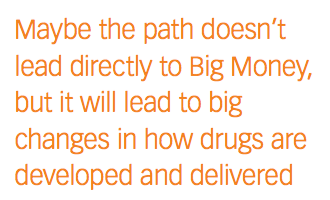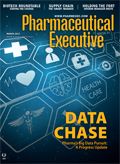Big Money and Big Data
Pharmaceutical Executive
No longer just hype, investing in big data is the path to the future for pharma, even if big returns aren't a direct result.
“Big Money goes around the world,” is the first line of a Rush song that goes through my head whenever I hear the words “Big Data.” Here are the rest of the lyrics for the first verse-”Big money goes around the world, Big money underground, Big money got a mighty voice, Big money make no sound, Big money pull a million strings, Big money hold the prize, Big money weave a mighty web, Big money draw the flies.” And on from there. But it makes sense, in a way, that if you replaced the word Money with Data in each of these
Lisa Henderson

sentences, it would work. Big Data started out in pharma overhyped a few years ago, and according to many IT experts, hasn’t yet reached its potential. But it will.
Let’s talk about the hype. In a recent discussion I had with technology and clinical trials experts, we struggled over using the term “Big Data.” Basically, we agreed that everyone hates the term because of the hype factor, but used it because people understand the term as it is referenced in journals and the like.
In this issue, our European Editor Julian Upton looks at big data and pharma’s response to see if the industry is poised to get past the hype and take advantage of its promise.
“I think it takes hype to get enough movement, to get pragmatism into the process,” Steve Rosenberg, Oracle’s SVP and general manager of its Health Science Global Business Unit, told Upton. “There’s not as much data as there is, for example, in banking applications. We are not talking about an unmanageable amount of data; it’s just a question of what it’s going to be used for. There’ll be pockets of success along the way. Two to three years from now you’ll see a pretty large proliferation of data, but until then the success will remain in certain therapeutics areas.”
Further, Upton interviews Berg Analytics Co-founder and Chief Analytics Officer Slava Akmaev, who says, there has been “a lot of resolve in the last two years on the big pharma side to invest in big data analytics, it is difficult to see how quickly companies just starting to move into the space will be able to show that their artificial intelligence (AI) or big data platforms can deliver products to the market.”
Getting to the money shot
Before we get to AI, however, let’s discuss what has to happen to data in the next two to three years. In the technology panel referred to above, and included in this article, David Evans, Managing Director, Accenture, LLP, said that getting to AI/Cognitive Computing is not an easy thing. He explained: “In machine learning, it has to have a gold standard of large volume and high quality endpoints to learn or determine decisions. You still have to build the big database using high-quality data in order for the machine to interpret what the unknown is so that it can learn.” This is how Big Data relates to AI. Without large volumes of high-quality data in a consistent format (achieved through standards), the pattern recognition, decision support, signal detection, etc., is not achievable.
Evans believes that data can also come from the Connected Computing sector-defined as all the Internet of things (IoT), wearables, connections, smartphones, sensors, etc., that offer real-time data everywhere. “As the connected universe expands, you will have large volumes of high quality data to go to Big Data, to inform analytics,” Evans said. “But currently, we have a

lot of data, but not the quality.”
As Rosenberg noted, there will be successes along the way, in certain therapeutic areas. And for that we can look directly to next-generation sequencing (NGS) data that characterize tumors and immune systems in the area of immuno-oncology. In this issue, Brandi Davis-Dusenbery, Senior Vice President of Science & Product for Seven Bridges Genomics, discusses the challenges biopharmaceutical executives have to de-silo information to take advantage of full potential of these NGS data sets, which can be useful in multiple settings and be used more in analytic decision-making.
While we learn to accept that Big Data is not hype, that pharmaceutical companies are starting on the path to high quality, shareable data that gets them to AI and better decisions, executives too will have to look at the costs. Investing in Big Data is the path to the future. Maybe the path doesn’t lead directly to Big Money, but it will lead to big changes in how drugs are developed and delivered.
Lisa Henderson is Editor-in-Chief of Pharm Exec. She can be reached at lisa.henderson@ubm.com. FollowLisa on Twitter: @trialsonline

Addressing Disparities in Psoriasis Trials: Takeda's Strategies for Inclusivity in Clinical Research
April 14th 2025LaShell Robinson, Head of Global Feasibility and Trial Equity at Takeda, speaks about the company's strategies to engage patients in underrepresented populations in its phase III psoriasis trials.
Beyond the Prescription: Pharma's Role in Digital Health Conversations
April 1st 2025Join us for an insightful conversation with Jennifer Harakal, Head of Regulatory Affairs at Canopy Life Sciences, as we unpack the evolving intersection of social media and healthcare decisions. Discover how pharmaceutical companies can navigate regulatory challenges while meaningfully engaging with consumers in digital spaces. Jennifer shares expert strategies for responsible marketing, working with influencers, and creating educational content that bridges the gap between patients and healthcare providers. A must-listen for pharma marketers looking to build trust and compliance in today's social media landscape.